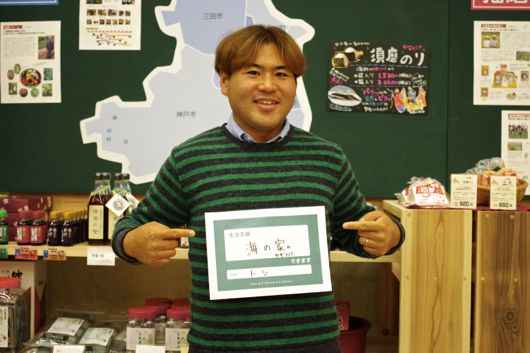
In memory of the 20th year since the Great Hanshin-Awaji Earthquake, an event themed to disaster-prevention was held in May 2014 at Suma Ward, Kobe City.
Masatoshi Kouchi, the owner of the Kappa Tengoku beach house that has been a mainstay of Suma Beach for more than 70 years, is one of the organizers of this event. While managing his beach house, he is also striving to build the local community together with the organizations and facilities in the Suma Beach area, and has been hosting numerous events as part of such efforts. This is because of his belief that “if the people in the area learn about each other and become friends, that would pave the quickest way towards being prepared for disasters.”
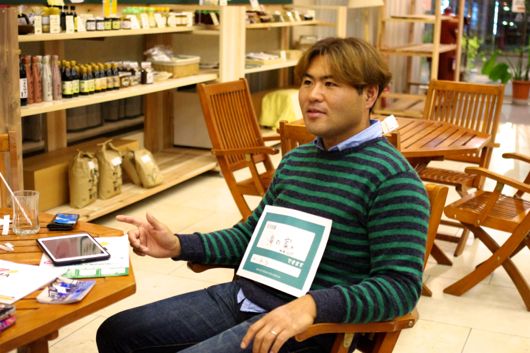 He learned about the earthquake at his lodge in Fukuoka, and he thought, “It’s all over.”
He learned about the earthquake at his lodge in Fukuoka, and he thought, “It’s all over.”
In January 1995, Kouchi was in his first year at university. He had spent the New Year’s holidays at his home in Suma, and had returned to his lodging in Fukuoka on January 15. And in the early morning hours of the 17th, he received a phone call from a friend from his university. The friend said, “Turn on the TV, something terrible happened in your hometown.”
The TV was showing live broadcasts of scenes taken from the air of the area right around my home, and when I saw the devastation of my local neighborhoods, I thought, “It’s all over.” After two days, I finally managed to get in touch with my family by telephone, and learned that they and my close friends were all safe. But, I decided I needed to be there with them, and made my way to Suma by car, taking several days to do so.
When he arrived, he found that his home, which had been rebuilt with reinforced concrete two years before the earthquake, was the only one standing. Almost all of the other houses in the area were in a state of complete collapse. In Kouchi’s own room within his house, he found a family of his neighbor housed there with cardboard boxes serving as partitions, because they had an infant with them, which made it difficult for them to stay at the local shelter. His family said to him, “If you stay, it’ll mean we’ll have to get food and water for one more person,” and so he ended up returning to Fukuoka on that same day.
Filled with feelings of uncertainty towards the recovery of his hometown, and of guilt from being the only one who wasn’t affected by the earthquake, eventually, Kouchi simply stopped thinking about the earthquake.
Hosting an event to fulfill his wish: “I want more people to learn to love Suma’s beach!”
After graduating from university, Kouchi returned to Kobe for employment. Later, at the age of 26, he started helping out at the Kappa Tengoku beach house, which was owned by his father, in order to follow in his father’s footsteps. While many things presented to him in this new job were new to him, the thing that he had most difficulty with was in building relationships with the part-time helpers in his position as their employer. There was a day when all of the staff didn’t show up to work, in revolt to his way of doing things.
And then one day, by the wish of his father, they decided to rent out their beach house for about two years. During this time, Kouchi thought deeply about how he should go about being the manager of a beach house. And that’s when he realized that the people in the neighborhood held negative impressions towards beach houses, such as thinking of them as being noisy and of disturbing the public peace. He wanted to get the local people to come to love the beach more, and decided to plan an event for the local residents.
And that was the start of the Suma Beach candle event, “Love & Candles: Love Letters in the Ocean Breeze” which was first held in 2007.
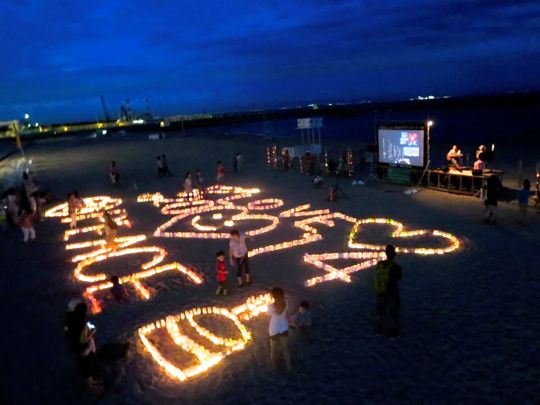 Photo: The 8th “Love & Candles: Love Letters in the Ocean Breeze” held this year. There were a variety of love letters, such as those declaring their love, as well as those addressed to people who have passed away.
Photo: The 8th “Love & Candles: Love Letters in the Ocean Breeze” held this year. There were a variety of love letters, such as those declaring their love, as well as those addressed to people who have passed away.
When Kouchi saw tears in the eyes of the participants as they gazed at the beautiful candles and the messages shown on the screen, he felt that it had helped to bring the local residents come slightly closer together. And the faces of the part-time workers at the beach house shone from having experienced the joy of being involved in moving people’s hearts.
I realized that what I could do for each of them is to give them this type of experience, so that they can all share in the process of thinking about and acquiring an understanding of what it means to work and to live.
Later, after Kouchi started managing Kappa Tengoku as its owner, he began planning one event after another on Suma Beach, with a focus on connecting the local people together and on being an event created by everyone together.
Suma Beach and the local community bond even more with the “Gyo-Gyo-Gyo Carnival”!
Kouchi first hosted the Fishing Port Market at Suma Fishing Port in 2011. By having fishermen sell their own fish themselves to the customers, he wanted to bring fishermen and consumers, who usually do not come in direct contact with one another, closer together. The event attracted 1,000 people, and both the visitors and the fishermen were delighted.
And so, he decided to make this event even larger, and make it into an opportunity for the residents in the entire area around Suma Beach to come closer together. With this objective, Kouchi started approaching organizations and facilities along the beach for their participation. And in the following year, the event evolved into the “Gyo-Gyo-Gyo Carnival” held at several locations simultaneously, and 2014 marked the third time this event was held.
And this is how S.O.S. (Suma Ocean Service) was formed as a gathering of nearby organizations and facilities: Nana Farm Suma, which sells local agricultural products; the famous Suma Aqualife Park Kobe aquarium; Wakamiya Shopping Street in the beachside area; the accommodation facility Seapal Suma; the local fishermen; and the beach houses.
 Photo: “Gyo-Gyo-Gyo Carnival” site map. Shuttle buses were in operation between the site and the train station for the convenience of the local people.
Photo: “Gyo-Gyo-Gyo Carnival” site map. Shuttle buses were in operation between the site and the train station for the convenience of the local people.
In Suma, shops and restaurants are concentrated in the south along the beach, and the north is where the residential houses are concentrated. Surprisingly, many of the residents do not visit the tourist facilities within their area. So, if we could effectively promote local attractions to the local people, I thought it would help to bring us closer together. On the day of the event, while taking on the role of guide on the shuttle buses, I explained to the local residents about how our members are good friends with each other, and that helped them feel more of an affinity towards us as well.
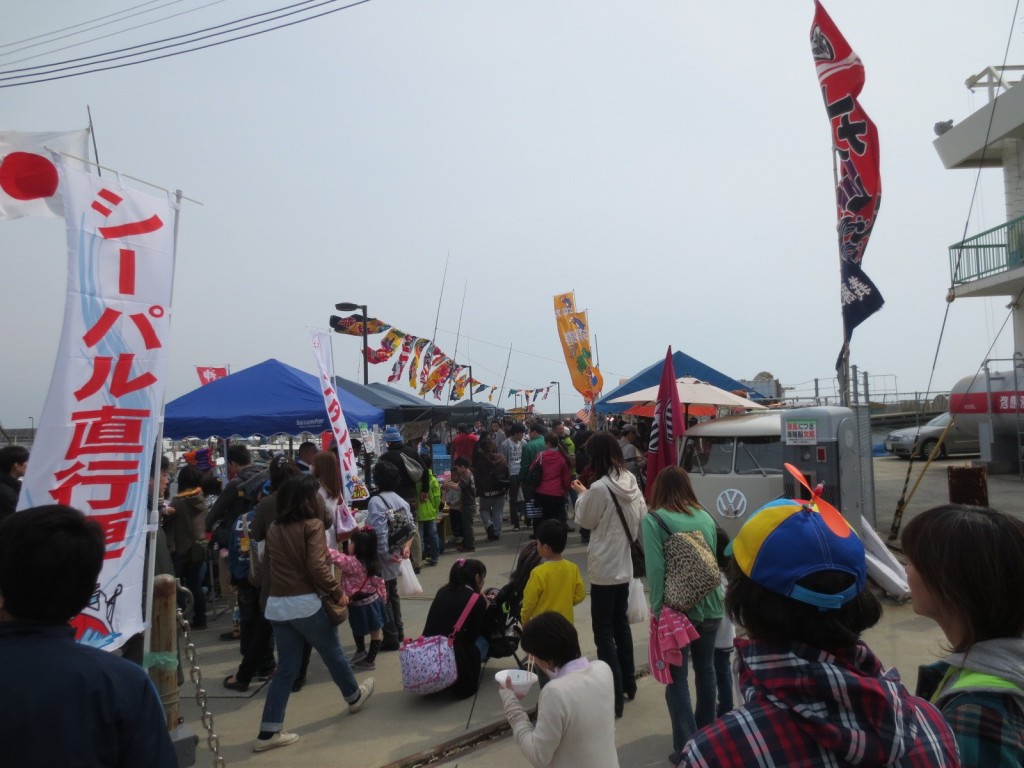 Photo: Many people gathered at the Fishing Port Market at Suma Fishing Port.
Photo: Many people gathered at the Fishing Port Market at Suma Fishing Port.
The first Gyo-Gyo-Gyo Carnival was a success, with about 3,000 people visiting, mainly from the local area. This served as a beginning in making the S.O.S. members much closer together, and for becoming more involved in efforts toward community building.
The path towards community building was laid by making disaster prevention its common theme.
Meanwhile, visitors mainly flocked to events at popular facilities, which gave rise to the issue of differences in proceeds, depending on where the event was held. After much deliberation, he hit upon the solution of hosting the events on the common theme of disaster prevention. The President of Seapal Suma, Junji Ichieda, submitted an application with Kobe City to have his own facility recognized as a shelter during times of disaster, which was accepted. It was then that Kouchi remembered a certain episode from 20 years ago.
When the earthquake closed off all roads by land, the fishermen still had their boats and the routes by sea. My father, who was a fisherman, used his own boat to go to Akashi Port and get kerosene and food from his fishermen friends. Because there were no communities at that time, information did not reach those in need, so there were many foods rotting at the port without being used.
If, in times of disaster, there are things that only a fisherman could do, then everyone must also have something that only they can do. For example, the Suma Aqualife Park Kobe could become a focal site for disaster relief activities, the beach houses could be a place for making food for many people, Nana Farm Suma can provide relief materials, and the people of the shopping street could serve as a neighborhood security watch.
Kouchi and his friends thought that in the process of community building, if everyone becomes friends and learns about what each person is capable of, and creates a relationship where they can help each other in times of need, then this would serve as an important measure towards preparing for disaster.
Since it was approaching the 20th year since the Great Hanshin-Awaji Earthquake, they decided to plan a community event linked to disaster prevention. After 20 years, Kouchi, who had initially been unable to think about the earthquake because of his lack of ability to do anything immediately after it happened, had begun to think about local disaster prevention from the standpoint of community building.
Disaster prevention event where you learn as you have fun, “SUMA Aso BOUSAI Mana BOUSAI”
In May 2014, an event for local residents and tourists in Suma called “SUMA Aso BOUSAI Mana BOUSAI” was held at Wakamiya Elementary School. The concept was to engage in “experiential disaster prevention training” where participants, both adults and children, would have an opportunity to enhance their awareness of disaster prevention by having fun and taking part in friendly games.
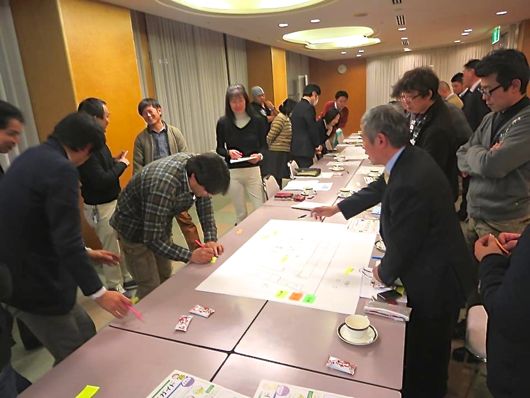 Photo: The meeting for the event, attended by people from the local community, itself served as training for disaster prevention.
Photo: The meeting for the event, attended by people from the local community, itself served as training for disaster prevention.
There were many programs offered that utilized the expertise of each occupation: for example, a game to hit a target with a water hose, hosted by the firefighters; a rope work program by the fishermen; a pool of igusa rush by the tatami makers; stretching instructions given by lifesavers, and others. These programs offered a fun way to inform participants of skills that would come in handy in times of need.
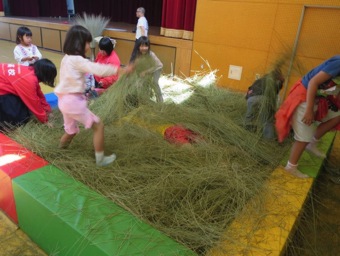 Photo: Pool of igusa rush, as a game for children staying at shelters
Photo: Pool of igusa rush, as a game for children staying at shelters
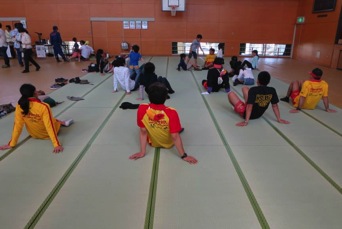 Photo: Stretching instructions for ways to alleviate physical inactivity during stays at a shelter
Photo: Stretching instructions for ways to alleviate physical inactivity during stays at a shelter
Visitors were asked to wear a “Dekimasu Bib [I can do this bib]” with their nickname and their skills on their chest. And this resulted in having a person who had written “giving a toast” as his skill actually give a toast at the after-party, thus serving to promote communication between local residents.
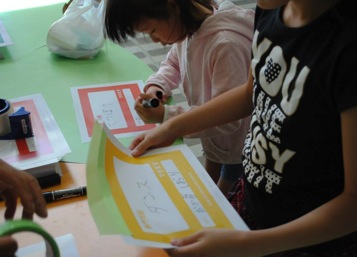 Photo: “Dekimasu Bib” was created in 2011 by the social design project “issue + design” of the UNESCO City of Design Kobe for people to help each other at the shelters.
Photo: “Dekimasu Bib” was created in 2011 by the social design project “issue + design” of the UNESCO City of Design Kobe for people to help each other at the shelters.
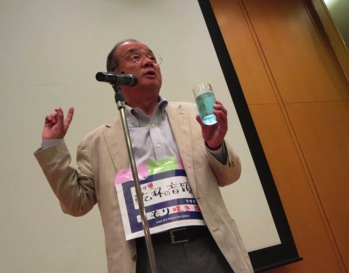 Photo: “Daikoryukai [Great Exchange Meeting]” was a great success, with the toast given by the President of Kinki Taxi Corporation, Kiyoto Morisaki
Photo: “Daikoryukai [Great Exchange Meeting]” was a great success, with the toast given by the President of Kinki Taxi Corporation, Kiyoto Morisaki
But from now on, I am not planning on conducting events that are mainly focused on disaster prevention. I think if we include disaster-prevention elements within the event, and reveal to participants after the fun that the skill learned during the event could come in handy during a disaster, and have participants input that fact into their memory in that manner, I think that is enough. Because after all, our main objective is community building.
Spreading the seeds for community building to the youth of the next generation
Kouchi teaches the youth who come to work part-time at his beach house about the common concepts of community building through the job. Those concepts are the 10 points for working at Kappa Tengoku.
Working at Kappa Tengoku
1.Be friendly with everyone that you meet
2.Clean and tidy up
3.Say thank you, and be thanked
4.Imagine things
5.Place importance on people, objects, and hearts
6.Look around
7.Give encouragement to others
8.Ask for praise when you made good effort
9.Become excited without any cause
10.Come to like everyone with all of your heart
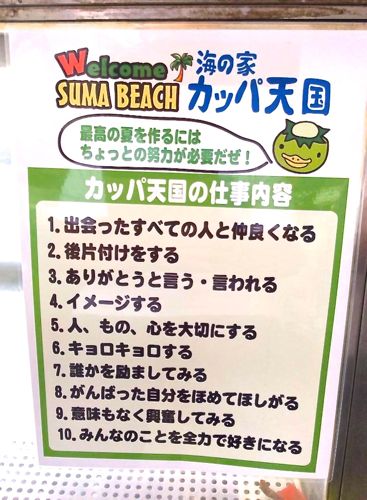
One day, when they come into position of managing others, I hope they will remember these words and realize the necessity of building a community. I am sowing seeds in them with such hopes.
Right now, those who had formerly worked for Kouchi are now keeping an eye on his activities from various areas in Japan through Facebook. If in the future, Kouchi’s activities should become connected to various other communities, and friendly communities that can help each other in times of disaster are created in different areas around the country, don’t you think this would be very heartening for us all?
Since Japan is a country that experiences many disasters, from now, building communities in local areas could become an important measure for preparing ourselves against disaster.
(Interviewed and written by Kyoko Murasaki)
This article was created with the cooperation of
greenz.jp.
![]() he owner of a beach house
he owner of a beach house JP | EN
JP | EN JP | EN
JP | EN

 Photo: The 8th “Love & Candles: Love Letters in the Ocean Breeze” held this year. There were a variety of love letters, such as those declaring their love, as well as those addressed to people who have passed away.
Photo: The 8th “Love & Candles: Love Letters in the Ocean Breeze” held this year. There were a variety of love letters, such as those declaring their love, as well as those addressed to people who have passed away. Photo: “Gyo-Gyo-Gyo Carnival” site map. Shuttle buses were in operation between the site and the train station for the convenience of the local people.
Photo: “Gyo-Gyo-Gyo Carnival” site map. Shuttle buses were in operation between the site and the train station for the convenience of the local people. Photo: Many people gathered at the Fishing Port Market at Suma Fishing Port.
Photo: Many people gathered at the Fishing Port Market at Suma Fishing Port. Photo: The meeting for the event, attended by people from the local community, itself served as training for disaster prevention.
Photo: The meeting for the event, attended by people from the local community, itself served as training for disaster prevention. Photo: Pool of igusa rush, as a game for children staying at shelters
Photo: Pool of igusa rush, as a game for children staying at shelters Photo: Stretching instructions for ways to alleviate physical inactivity during stays at a shelter
Photo: Stretching instructions for ways to alleviate physical inactivity during stays at a shelter Photo: “Dekimasu Bib” was created in 2011 by the social design project “issue + design” of the UNESCO City of Design Kobe for people to help each other at the shelters.
Photo: “Dekimasu Bib” was created in 2011 by the social design project “issue + design” of the UNESCO City of Design Kobe for people to help each other at the shelters. Photo: “Daikoryukai [Great Exchange Meeting]” was a great success, with the toast given by the President of Kinki Taxi Corporation, Kiyoto Morisaki
Photo: “Daikoryukai [Great Exchange Meeting]” was a great success, with the toast given by the President of Kinki Taxi Corporation, Kiyoto Morisaki